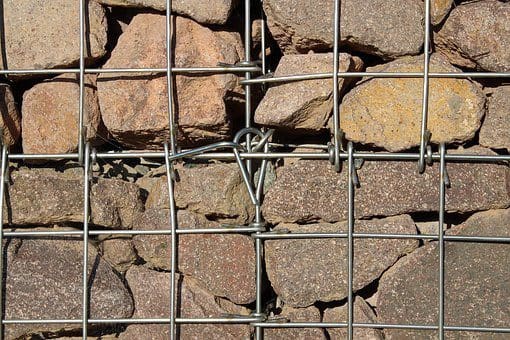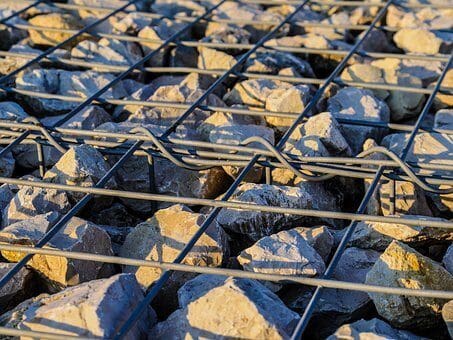Gabions are highly useful tools that were created long ago for defensive and structural purposes. Nowadays, they remain a staple in constructional operations, but they have also begun to appear in more creative commercial and residential undertakings.
A Guide to Understanding Gabions
A gabion is a mechanism made of wire that cages in sizeable debris. This word is actually a derivative of another that means large cage. The contents most often seen underneath the wires are types of terrain such as rocks and boulders, dirt, soil, or logs. However, the list goes on when the gabion is applied to alternate activities.
The gabion is essentially a heavy-duty type of hog wire. It's a mesh (otherwise known as a grid) of steel that has been treated to withstand a harsher amount of pressure from its contents and the elements.
At one time, gabions were made of lightweight wicker. It wasn't perfect, but it was innovative and effective. These days, gabions employ the tougher material which gives them greater strength and lifespan.

What is the Purpose of a Gabion?
As the name suggests, this cage is meant to contain or trap, and they're used in the makings and maintenance of dams, foundations, pathways, trenches, sculptures, and more.
If you've ever driven through a natural bridge and marveled at the bravery of the workers who made it, you can also thank them for installing gabions to keep the rock and landslides at bay.
In recognizing the feat of trapping rocks and other mass debris from falling onto the areas beneath, one must also applaud this contraption in its ability to serve as a means to defend and support.
Gabions are an ancient technology used to fortify riverbanks, protecting nearby encampments and settlements from potential erosion. They've been helpful in quick and simple wall assemblies for military setups as well. Presently, gabions are being noticed for their aesthetic appeal as well as their functionality.
Where is it Used?
The usefulness of this tool allows it to be as versatile as necessary. Therefore, gabions are appealing to different people for different reasons. The fact that they serve a purpose, but also potentially increase curb appeal, makes them easily applicable to various environments.
Although you probably didn’t know the name, there are countless gabions displayed throughout cities and states, especially surrounding the mountainous regions and large bodies of water. Many travelers will see them alongside a precipitous highway as they climb up and brace the cliffs that tower above.
Other locations for gabions are typically lining road construction or other large-scale construction sites. They prove to be very effective in acting as retainers for chunks of debris that may hinder a project or harm passersby.
As mentioned, they were once a staple in the development of communities that flocked toward rivers. During wet seasons, the riverbanks were (and still are) subject to erosion, putting the community at risk. Creating pathways for flowing water to cities and for traveling through rough terrain are also jobs that are filled by gabions worldwide.
While a gabion may not seem so by these select encounters, its usefulness is not limited to creating roadways. You can actually use gabions in your own personal landscaping endeavors at your home or commercial lot. While using them in your own backyard is fairly new, the idea was bound to occur because of the gabion's many benefits.

What are the Benefits of a Gabion?
We have many other options for construction, stability, and décor, but gabions are often preferred because they deliver a powerful combination of features that no other method can. The key thing to remember about gabions, and why they're becoming so popular in the non-engineering world, is that they are semi-cheap, semi-permanent, and semi-simple.
Cost-Effective
By filling the gabion with materials native to your area, you're more likely to save money both initially and long-term. Whatever you pay to install and customize the look of your gabion project, the increase in property value, enticing appearance for customers or guests, and the lengthy lifespan will help this addition pay for itself in no time.
You can fill the gabion with any item that suits your fancy as long as it won't slip through the grid, and the options are nearly endless. Also, by choosing options such as concrete or stone from demolition sites, you're reducing the amount of waste and energy needed to break it down for reuse.
Long-Lasting
The wiring is durable enough to contain heavier materials like concrete, yet flexible enough that you can shape it to your own desired forms. For example, if you'd like gabions around a firepit or constructed in an intricate shape to hold collectibles, bending the wires is an easy option.
However, the steel material is welded to ensure that it doesn't bend under pressure and holds its form, so your ideas should be presented to a professional capable of assisting you in your endeavors.
Gabion wiring materials come in an assortment of options for buyers that vary depending on the job. Baskets are largely available in a galvanized steel that lasts a decade (perhaps longer when applied to lighter jobs or simple landscaping).
Another option is the heavier duty gabion baskets that are coated in galfan, a combination of aluminum and zinc. This is a more expensive, but highly necessary option for bigger jobs like those you'd find on roadsides and in construction. The galfan coating simply protects the metal from the elements for longer, but the strength and durability come from the design of the cage.
They were designed for big jobs. They're also resilient, but they don't have to be a permanent fixture in your lawn if you ever change your mind. The ease of assembly requires nothing more than placing the baskets as you like, filling them up, and fastening the wire in place.
The grid pattern of the gabion lets water, air, and light pass through each crevice, so there is a lesser chance for the elements to knock down retainer walls. When it comes to stability without a foundation, the heavier the filler material, the better.
Placing stone-like items that imprint themselves into the ground more and more with added weight helps with permanence and solidity. A hundred pounds of rock is already hard to move, but it becomes even tougher as it forces a constant pressure into the ground, gaining a stronger bearing in time.
Additionally, this ability to shape the environment makes the gabion a most effective architectural device in areas prone to shifts in the earth. For example, regions that experience heavier rain or snowfall, earthquakes, or other phenomena that cause the earth to change beneath your feet.
Even if you're not a resident of a changing environment, the knowledge that your landscape contains such a substantial, sustainable, and long-lasting component is something worth appreciating.
Efficient Assembly and Quality Products
Assorted Goods
You don't have to think large-scale with gabions. A wonderous feature is that they're available for purchase in cut panels, lengthy rolls, or sizeable baskets. The welded, treated mesh wire comes in all manners of cuts and installs very quickly.
Depending on your ideal placement, there is a gabion basket that fits best. Whether you intend to build an aquatic arrangement, vertical accent wall, heavyweight boundary, or soundproof barrier, there is a particular gabion manufactured for high-performance in that arena.
Simple Installation
The assembly process doesn't require much more than having the inspiration and following through with installation, which is remarkably simplistic. There is no need to lay any initial foundation as the contents within are generally bulk items that create a natural grounding for themselves.
The gabion itself is merely there to serve as a reinforcement and containment. It can be large, premeasured baskets that you fill and stack or line up. It can be a series of panels that are linked together to create baskets in the sizes you prefer, or it can be a roll of mesh wire that is cut to lengths that aren't offered.
The reason gabions are shaped into basket formations is because they're smaller and easier to transport or shift one by one as opposed to a single, large enclosure full of material. If you're considering a DIY gabion, remember that working in increments is wiser than attempting a complete coverage in one fell swoop.
A Personal Touch
It's customizable to an extent and can be a range of heights, opening itself to endless possibilities, and the possibilities continue as you choose the contents within the gabion.
Although harder, heavier parts are the go-to for filling up a gabion, you have a chance to really make a statement with your landscape as you fill your gabions with objects according to your needs.
Retainer walls need heavy objects that compact together and hold their form. They can't be something that easily bows or breaks under immense pressure. This is why stones or concrete are often the top choices here.
Some homeowners choose to place crystal, glass, or other transparent substances inside lower gabions and illuminate them with LED lights at the bottom or weaved through the crags and crevices. This idea isn't meant for holding up walls, but it makes for a unique surrounding for a fish pond or bar.
Perhaps you'd like a seating area for outdoor dining. You can fill gabions of differing heights as you please and top them with smooth cuts of wood to make seats and tables. They can be transformed into benches, counters, bars, or any other flat-surfaced furniture that can also stretch to lengths beyond those of store-bought furnishings. This is an ideal solution for people on a budget.
You can now use this technology to obtain the firepits, waterfalls, raised planters, ponds, and sculptures you've been craving. Landscaping architects are known for getting creative with projects, and gabions are no exception to their talents. Gabions are used in the civil engineering world frequently and have been adopted into the world of commerce and residence seamlessly.

How to Get Started
Knowing what you want and getting a professional consultation helps to plan out the process. When considering something elaborate or highly dependent on a sound framework, a professional is the way to go.
This is especially the case for retainer walls as they call for a specific and trained eye to know the proper placement and material to use. For smaller tasks, the process should be simple enough if you already have a good grasp of what you'd like to create and the best way to proceed.
Using a gabion for modern landscaping plans is one of the greatest ways to get creative on a budget. While it does take some planning and knowledge to install gabions properly, they assemble quickly and offer a very natural look to your landscape that lasts through any weather for spans of 10 to 40 years.
